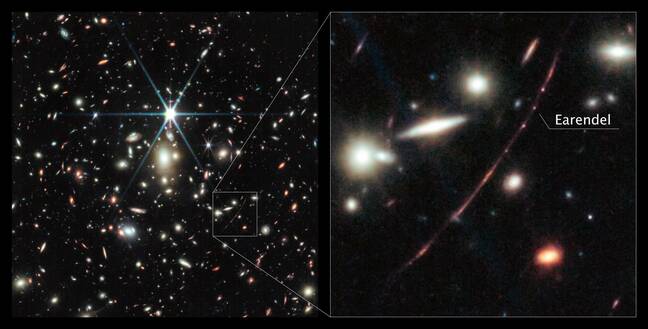Most distant observed star is blue – and it isn't alone
Light from Earendel takes 12.9 billion years to reach Earth, and it's serendipitous the JWST can see it at all
It was a little more than a year ago that NASA's Hubble Space Telescope spotted the most distant star ever observed: the 12.9 billion light-years-away Earendel.
Now the James Webb Space Telescope has taken its own measurements, offering an unprecedented glimpse of an object that formed within the first billion years of the universe.
Webb's Near-Infrared Camera, or NIRCam, was able to determine that Earendel ("morning star" in Old English) is incredibly bright – around a million times more luminous than our Sun, and twice as hot, to boot. What's more, the JWST was even able to determine what color Earandel would be were we able to see it a bit more clearly: as a B-type star it's likely quite blue.
Earendel's colors also suggest it's not alone, which was a surprise to Webb scientists. While stars Earendel's size often have companion suns, NASA said it expected Earendel would be too close to any companion, relative to its distance to Earth, to be distinguishable from it. That wasn't the case, though.
"Based solely on the colors of Earendel, astronomers think they see hints of a cooler, redder companion star," the folks at NASA said this week, adding that the light needed to make that observation had been stretched by the expansion of the universe past the point where Hubble's instruments could even detect it.
Thank you, space-time wrinkle
The previous most-distant star record was held by Icarus, which was discovered by Hubble in 2018 and is a paltry nine billion light years from Earth. Earendel, light from which took nearly four billion more years to reach Earth than light from Icarus, would normally still be beyond our realm of observation. Thankfully a massive distortion in space-time magnified it by a factor of at least 4,000, allowing it to be seen, NASA explained.
Earendel and its parent galaxy, the Sunrise Arc, are only visible thanks to what NASA calls "its lucky alignment behind a wrinkle in space-time" created by galaxy cluster WHL0137-08. The massive cluster sits between Earth and the Sunrise Arc and has so much gravitational pull it acts like an intergalactic magnifying lens. Hence the apt name for the phenomenon: gravitational lensing.

A zoom-in on Earendel, the most distant-ever observed star, as photographed by the JWST – Click to enlarge. Credit: NASA, ESA, CSA, D. Coe (STScI/AURA for ESA; Johns Hopkins University), B. Welch (NASA's Goddard Space Flight Center; University of Maryland, College Park). Image processing: Z. Levay (High-res version)
Along with what we've learned about Earendel, NASA said that it's learned some new information about the Sunrise Arc. Astronomers were able to spot star-forming regions – some as young as five million years old – and older established star clusters inside the Sunrise Arc. One discovered star cluster, thought to be around ten million years old, is believed to be gravitationally bound – meaning it likely still exists today.
"This shows us how the globular clusters in our own Milky Way might have looked when they formed 13 billion years ago," the US space agency noted.
- James Webb spots water vapor in rocky planet-forming disk
- Viasat says latest broadband satellite failed to fully deploy antenna
- Way out in deep space, astronomers spot precursor of carbon based life
- James Webb spots the early galaxies responsible for tidying up the universe
The Webb team said it has been able to use similar gravitational lensing effects to detect other far-flung stars since discovering Earendel peeking out from behind WHL0137-08, but none have been as distant as the star named for JRR Tolkien's half-elven guardian of Middle Earth's Sun and Moon.
Legendarium aside, NASA is hopeful that gravitational lenses like the one created by WHL0137-08 could finally help them confirm the existence of so-called Population III stars – primordial giants that emerged shortly after the Big Bang but have long since detonated, seeding the cosmos with heavy elements. ®
 Biting the hand that feeds IT
Biting the hand that feeds IT